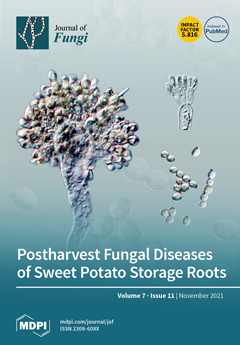Solid-based residues (SBRs) left from harvesting the fruiting bodies of cultured
Cordyceps mushrooms are a challenge to sustainability. Therefore, in this study, the SBRs from the cultivation of
Cordyceps militaris (
C. militaris) via solid-state fermentation (SSF) were employed to prepare crude
[...] Read more.
Solid-based residues (SBRs) left from harvesting the fruiting bodies of cultured
Cordyceps mushrooms are a challenge to sustainability. Therefore, in this study, the SBRs from the cultivation of
Cordyceps militaris (
C. militaris) via solid-state fermentation (SSF) were employed to prepare crude extracts, with the aim of considering their possible use in cosmetics. The SBRs obtained from cultivation with solid media containing defatted rice bran mixed with barley, white rice, Riceberry rice, and wheat were named SBR-B, SBR-R, SBR-Rb, and SRB-W, respectively. They were extracted with solvents of differing polarity and then evaluated for their total phenolic content (TPC), total flavonoid content (TFC), and total carbohydrate content (TCC). In addition, antioxidant and tyrosinase inhibitory activities, photoprotection, and cytotoxicity were also assessed. The results revealed that the total bioactive contents and biological capacities of crude SBR extracts were significantly influenced by the types of SBR and extraction solvent (
p < 0.05). The SBR-B extracted with hot water exhibited the highest antioxidant activity (66.62 ± 2.10, 212.00 ± 3.43, and 101.62 ± 4.42 mg TEAC/g extract) when assayed by DPPH, ABTS, and FRAP methods, respectively, whereas tyrosinase inhibitory activity (51.13 ± 1.11 mg KAE/g extract) with 90.43 ± 1.96% inhibition at 1 mg/mL was excellently achieved by SBR-Rb extracted by 50% (
v/
v) ethanol. Correlations between bioactive contents in the crude extracts and their biological activities were mostly proven at a strong level (
p < 0.01). The capability of the crude extracts to absorb UV over the range of 290–330 nm disclosed their potential roles as natural UV absorbers and boosters. Cytotoxicity analysis using fibroblast cell lines tested with hot water and 50% (
v/
v) ethanolic SBR extracts demonstrated safe use within a concentration range of 0.001–10 mg/mL. Interestingly, their fibroblast proliferative capacity, indicating anti-aging properties, was highly promoted. The chemical composition analyzed via LC–MS/MS techniques showed that seven phenolic acids and four flavonoids were identified in the crude SBR extracts. Furthermore, the other compounds present included nucleosides, nucleobases, amino acids, sugars, phospholipids, alkaloids, organic acids, vitamins, and peptides. Therefore, it is emphasized that SBRs from
C. militaris can be a prospective source for preparing crude extracts employed in cosmetics. Lastly, they could be further utilized as multifunctional ingredients in cosmetics and cosmeceuticals.
Full article






